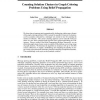Free Online Productivity Tools
i2Speak
i2Symbol
i2OCR
iTex2Img
iWeb2Print
iWeb2Shot
i2Type
iPdf2Split
iPdf2Merge
i2Bopomofo
i2Arabic
i2Style
i2Image
i2PDF
iLatex2Rtf
Sci2ools
NIPS
2008
2008
Counting Solution Clusters in Graph Coloring Problems Using Belief Propagation
We show that an important and computationally challenging solution space feature of the graph coloring problem (COL), namely the number of clusters of solutions, can be accurately estimated by a technique very similar to one for counting the number of solutions. This cluster counting approach can be naturally written in terms of a new factor graph derived from the factor graph representing the COL instance. Using a variant of the Belief Propagation inference framework, we can efficiently approximate cluster counts in random COL problems over a large range of graph densities. We illustrate the algorithm on instances with up to 100, 000 vertices. Moreover, we supply a methodology for computing the number of clusters exactly using advanced techniques from the knowledge compilation literature. This methodology scales up to several hundred variables.
Cluster Counting Approach | Factor Graph | Graph Coloring Problem | Information Technology | NIPS 2008 |
| Added | 29 Oct 2010 |
| Updated | 29 Oct 2010 |
| Type | Conference |
| Year | 2008 |
| Where | NIPS |
| Authors | Lukas Kroc, Ashish Sabharwal, Bart Selman |
Comments (0)

